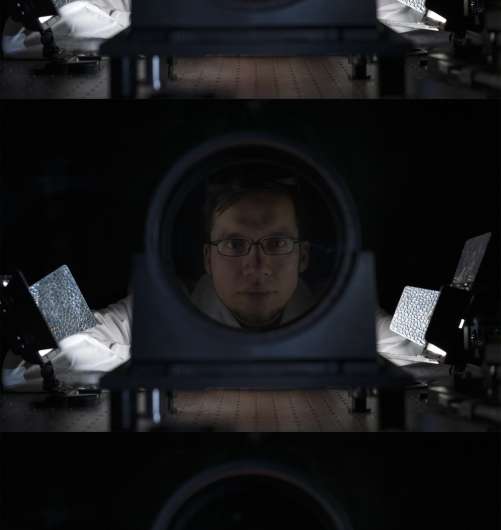Physicists from Warsaw have generated ultrashort laser pulses in an optical fiber, by using a method previously considered as physically impossible to achieve. Pictured above: Jan Szczepanek, a Ph.D. student from the Faculty of Physics of the University of Warsaw, at the innovative fiber laser. Credit: IPC PAS, Grzegorz Krzyzewski
Pulse lasers built entirely on optical fibers are increasingly used by industry. Optical scientists from the Warsaw Laser Centre of the Institute of Physical Chemistry of the Polish Academy of Sciences and the Faculty of Physics of the University of Warsaw have generated ultrashort laser pulses in an optical fiber with a method previously considered to be physically impossible. Their solution is not only useful, but also surprisingly simple.
An innovative fiber laser has been developed at the Laser Centre of the Institute of Physical Chemistry of the Polish Academy of Sciences (IPC PAS) and the Faculty of Physics of the University of Warsaw. Using a simple solution, the Warsaw optical scientists have "forced" one of the types of optical fiber lasers to generate ultrashort, high-energy pulses. The new laser is devoid of any mechanically sensitive external parts, which seems to be especially interesting for future applications. The invention greatly expedites the processing of materials in industrial laser machines.
"Fiber lasers can be built so that all the processes important for the generation and shaping of the ultrashort pulses takes place in the fiber itself. Such devices, without any external mechanically sensitive components, operate in a very stable manner, and are ideal for working in difficult conditions," says Dr. Yuriy Stepanenko (IPC PAS).
Laser action in the fiber leads to the generation of a continuous light beam. The release of energy in the shortest possible pulses is, however, much more favourable, since it signifies a great increase of power. Pulses are generated in fiber lasers via a saturable absorber system. When the light intensity is low, the absorber blocks light; when it is high, the absorber lets it through. Since femtosecond pulses have greater intensity than a continuous beam, the parameters of the absorber can be adjusted so that it only admits pulses.
"Up to now, graphene sheets, among others, have been used as the saturable absorbers, in a form of a thin layer deposited on the tip of the fiber. But the diameters of optical fibers are in the order of single microns. Even a little energy cramped in such a small cross-section has a significant density per unit area, affecting the lifetime of the materials. Therefore, if an attempt was made to increase the power of the femtosecond pulses, the graphene on the tip of the connector was destroyed. Other absorbers, such as carbon nanotubes, may also undergo degradation," explains Jan Szczepanek, a PhD student from the Faculty of Physics of the University of Warsaw.
In order to generate higher energy femtosecond pulses in the optical fiber, the Warsaw physicists decided to improve saturable absorbers of a different type, via the clever use of optical phenomena such as nonlinear effects that cause a change in the refractive index of glass.
A nonlinear artificial saturable absorber works as follows. The plane of polarization of low intensity light beam does not change in the absorber and the output polarizer blocks the light (images at the bottom). At a high enough intensity, typical for femtosecond pulses, the plane rotates 90 degrees and the light pulse passes through the polarizer. Credit: IPC PAS, Grzegorz Krzyzewski
Electric and magnetic fields of light usually oscillate in random, mutually perpendicular directions. When the fields oscillate all the time in the same plane, the wave is called linearly polarized. In classical optics, it is assumed that when such a wave passes through a medium, it experiences a constant refractive index, regardless of the light intensity. In nonlinear optics this is different: At a sufficiently high light intensity, the refractive index begins to increase slightly.
A nonlinear artificial saturable absorber works as follows. At the input, the linearly polarized light is divided into a beam with a low intensity and a beam with a high intensity. The medium of the absorber can be chosen for both light beams to experience a slightly different refractive index in order for them to travel at slightly different (phase) velocities. As a result of the velocity difference, the plane of polarization starts to rotate. At the output of the absorber, there is a polarization filter that only lets through waves oscillating perpendicularly to the plane of polarization of the incoming light. When the laser is operating in continuous mode, the light in the beam is of a relatively low intensity, an optical path difference does not occur, the polarization does not change, and the output filter blocks the light. At a high enough intensity, typical for femtosecond pulses, the rotation of polarization causes the pulse to pass through the polarizer.
For the saturable absorber with polarization rotation to work, the fibre must have different refractive indices in different directions (thus it has to be birefringent), and both indices should also be stable. The problem is that in ordinary optical fibers, birefringence occurs accidentally, e.g. due to stress caused by the touch of a finger. Lasers built in this manner are extremely sensitive to external factors. In turn, birefringence of the polarization preserving fibers is so large that the light propagates in only one direction, and the construction of artificial saturable absorbers becomes physically impossible.
"Birefringent optical fibers retaining the polarization state of the entering light are already in production. We are the first to demonstrate how they can be used to construct a saturable absorber: We cut the optical fiber into segments of an appropriate length and then reconnect them, rotating each successive segment 90 degrees in relation to its predecessor," says Ph.D. student Szczepanek.
"Rotation means that if in one segment a pulse with, shall we say, vertical polarization travels slowly, in the next, it will run faster and catch up with the second pulse, polarized perpendicularly. A simple procedure has therefore allowed us to eliminate the main obstacle to increasing the energy, that is, the great difference in velocities between pulses of different polarities, typical for all polarization preserving fibres," explains Dr. Stepanenko.
The more rotated segments there are, the better the quality of the pulses generated in the fiber. In the laser built in the Warsaw laboratory, the saturable absorber consisted of a fiber with a length of approximately 3 m, divided into three segments, and a filtering polarizer. The potential number of rotated segments can be increased up to even a dozen or so.
The new laser produces high-quality femtosecond pulses, and their energy can be up to 1000 times larger than typical for lasers with material absorbers. In comparison to the devices with artificial absorbers, the laser made by Warsaw scientists has a much simpler construction and therefore its reliability is significantly greater.
More information: Jan Szczepanek et al, Ultrafast laser mode-locked using nonlinear polarization evolution in polarization maintaining fibers, Optics Letters (2017). DOI: 10.1364/OL.42.000575
Journal information: Optics Letters
Provided by Polish Academy of Sciences
























